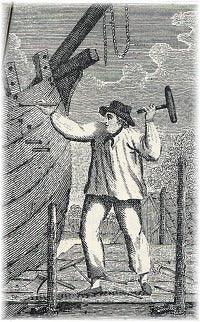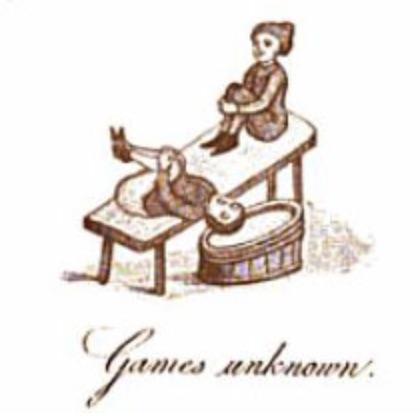The Regency Dentist
There was a tooth amiss. Harriet really wished, and had wished some time, to consult a dentist. Mrs John Knightley was delighted to be of use; any thing of ill health was a recommendation to her -- and though not so fond of a dentist as of a Mr Wingfield, she was quite eager to have Harriet under her care. -- When it was thus settled on her sister's side, Emma proposed it to her friend, and found her very persuadable. -- Harriet was to go; she was invited for at least a fortnight; she was to be conveyed in Mr Woodhouse's carriage. -- It was was all arranged, it was all completed, and Harriet was safe in Brunswick Square. Emma
A beautiful smile can make a lasting impression and in Jane Austen's works a "good teeth" go a long way in providing that initial spark. Henry Crawford, Mrs. Croft and Elizabeth Bennet are all said to have good, or at the least, "tolerable" teeth. Was it so uncommon a thing to find that it must be commented upon by those taking that first impression? During the Regency, the answer seems to be yes. In a time before braces, crowns, whiteners and veneers, teeth were considered a thing to be hidden. Taking their cue from Mona Lisa, lips were kept tightly shut in portraits-- to show teeth was thought to show low breeding. A stiff point of view, perhaps, but what better way to hide missing teeth or ill fitting dentures!  In 1787, artist Madame Vigée-Lebrun caused enormous controversy when she unveiled a smiling self-portrait in the Paris Salon... in which she revealed beautifully white teeth. Her critics considered this a shocking and almost revolutionary act. One contemporary roundly condemned it as "an affectation...which shows no precedent amongst the Ancients."*
In 1787, artist Madame Vigée-Lebrun caused enormous controversy when she unveiled a smiling self-portrait in the Paris Salon... in which she revealed beautifully white teeth. Her critics considered this a shocking and almost revolutionary act. One contemporary roundly condemned it as "an affectation...which shows no precedent amongst the Ancients."*
The majority of the population was not so blessed and a trip to the dentist was a not uncommon occurance. While visiting the dentist because of a toothache is never a pleasant experience, only consider how much more dreaded such a trip would be without all the modern medical wonders that make it relatively clean and painless to receive a filling or extraction! In Jane Austen’s day, such a visit for a middle class young lady might include a trip to London, for only there, could one be assured of “quality” dental care. No doubt this visit, during which Jane accompanied three of her nieces to a London Dentist, inspired a similar trip for Harriet Smith, in Emma.
The poor girls and their teeth! I have not mentioned them yet, but we were a whole hour at Spence's, and Lizzy's were filed and lamented over again, and poor Marianne had two taken out after all, the two just beyond the eye teeth, to make room for those in front. When her doom was fixed, Fanny, Lizzy, and I walked into the next room, where we heard each of the two sharp and hasty screams.
The little girls' teeth I can suppose in a critical state, but I think he must be a lover of teeth and money and mischief, to parade about Fanny's. I would not have had him look at mine for a shilling a tooth and double it. It was a disagreeable hour. Jane Austen to Cassandra, Sept. 16, 1813  Although the practice of Dentistry goes back to ancient times, not much developed over the centuries. Dental care was pretty grim prior to modern times. The Dental profession owes a debt of gratitude to a remarkable Frenchman named Pierre Fauchard (1678-1761). Known as the father of modern dentistry, Fauchard collected all that was known in the West up to that time, organized the material and presented it in an epic work, published in 1723: Lel Chirurgien dentiste; ou, traite des dents (The Surgeon-Dentist; or Treatise on Teeth). He was the first to practice dentistry in a scientific manner, practice management techniques for the enhancement of patient comfort, and advocate what today we call dental health.*
Although the practice of Dentistry goes back to ancient times, not much developed over the centuries. Dental care was pretty grim prior to modern times. The Dental profession owes a debt of gratitude to a remarkable Frenchman named Pierre Fauchard (1678-1761). Known as the father of modern dentistry, Fauchard collected all that was known in the West up to that time, organized the material and presented it in an epic work, published in 1723: Lel Chirurgien dentiste; ou, traite des dents (The Surgeon-Dentist; or Treatise on Teeth). He was the first to practice dentistry in a scientific manner, practice management techniques for the enhancement of patient comfort, and advocate what today we call dental health.*
At the time of the Regency, oral hygiene was not a well advocated practice. Only simple instruments were available for cleaning the teeth. Toothpicks were common and even fashionable, but toothbrushes, most often frayed sticks for chewing on or hogs hair toothbrushes, were in limited use. Unpalatable whiteners such as burnt bread or charcoal were used along with these, though they must have been of little help. Toothaches and cavities were common.
Unfortunately for the sufferer, tooth extraction was the only quick means of alleviating dental pain at the time. Extraction instruments were known as pelicans and keys. The pelican was a brutal instrument with a pad or bolster, which was placed on the side of the gum below the tooth to be extracted and a beak or claw which engaged the opposite side. A downward twist of the handle tore the tooth out of the mouth. The key was similar, but had a handle similar to that of a corkscrew and enabled the instrument to be used more comfortably from the front of the mouth instead of the side.
The 1860s these tools were replaced by forceps, which engaged the tooth more anatomically and extracted with much less damage. Nevertheless naval surgeons still had extraction keys in their kits in the 1880s.  Once a tooth had been extracted, the only solution for filling the gap was donor teeth (usually pulled fresh from a willing accomplice who would rather have cash than teeth) set into the hole where the tooth had been pulled from, or dentures. Prior to 1850 dentures generally did not fit well.
Once a tooth had been extracted, the only solution for filling the gap was donor teeth (usually pulled fresh from a willing accomplice who would rather have cash than teeth) set into the hole where the tooth had been pulled from, or dentures. Prior to 1850 dentures generally did not fit well.
George Washington’s teeth (pictured above), contrary to "common knowledge" were not made of wood. They were made from whalebone, and others from hippopotamus. There were springs attached, making them rather uncomfortable to wear. In prior centuries, teeth were made from a variety of materials including - in addition to whalebone, walrus and hippopotamus tusks - china, ivory, earthenware, tortoise shell, coral and more.**
The Regency era did give rise to many innovations in dental care, including fillings for cavities, which were first developed in the early 1800s. Later variations of filling material, from tin to Gold, had quantities of mercury involved which must have caused more damage to the patient than not. Levi Spear Parmly promoted teeth flossing with a piece of silk thread in 1815. In 1824, a dentist named Peabody was the first person to add soap to toothpaste. Mass-produced toothpaste would not be distributed until Colgate developed a patented formula in 1873. Before that time, homemade teeth whitening recipes could be found in nearly every household book.
More Teeth, Colin Jones Dentistry as an Art by Edward Feinberg, DMD**
A Glasgow Dentist, an Edinburgh Legacy, by Paul Geissler***
Enjoyed this article? If you don't want to miss a beat when it comes to Jane Austen, make sure you are signed up to the Jane Austen newsletter for exclusive updates and discounts from our Online Gift Shop.



3 comments
Over this particular blog you will get to know about the regency dentist.This article is very helpful and interesting. I enjoyed reading this article as it provided me lots of information regarding it. You will get best review over here and would suggest others too. Great blog indeed, will visit again future to read more!!I never thought will get to visit this Whiteningco.nz oh, has some nice content for everyone.
How to whiten teeth
[…] nightmare. The main fix for a cavity was simply pulling the tooth out, which the Jane Austen Center explains was often done with a pelican or key, both metal instruments that were braced against the gum and […]
Jane Austen’s Handwritten Letter About a Nightmarish Visit to the Dentist Is Up for Auction | All UR News en_CA
[…] to the Jane Austen Center, oral hygiene was “not a well advocated practice” during the author’s lifetime. Simple tools […]
The Alpha-Phonics Blog
Leave a comment
This site is protected by hCaptcha and the hCaptcha Privacy Policy and Terms of Service apply.